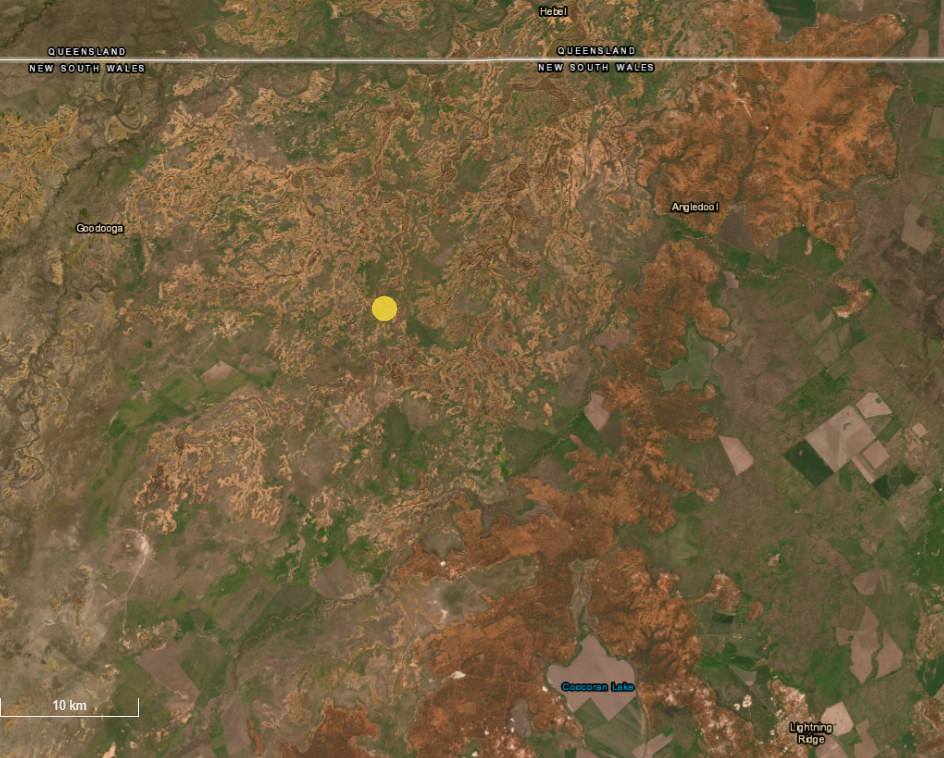Did you feel the earth move?
Lee O'Connor
10 April 2023, 3:40 AM
 Seismogram from Cobar around time of Thursday's quake. Thin dotted red line indicates time of quake. Seismic waves arrive some time later, depending on distance. Source: IRIS Buffer of Uniform Data (BUD) webtool
Seismogram from Cobar around time of Thursday's quake. Thin dotted red line indicates time of quake. Seismic waves arrive some time later, depending on distance. Source: IRIS Buffer of Uniform Data (BUD) webtoolNews is in of a minor earthquake near Goodooga on Thursday afternoon and, if you felt it, Geoscience Australia would like to know.
The tremor occurred just after 3:49pm on Thursday 6 April and was captured by seismic stations hundreds of kilometres away.
At this early stage, it is estimated to be of a local magnitude of 3.1 on Australia's magnitude scale.
The epicentre of the earthquake was more than 20 kilometres east south east of Goodooga towards Angledool Lake and thought to have occurred around 10 kilometres below ground.
Geoscience Australia runs around one hundred seismic stations across the continent to locate and record earthquake magnitudes.
The station closest to this quake is at Roma, Queensland 314 kilometres away, which measured the tremor at 3:50:20pm on Thursday 6 April, followed by the station at Cobar, 325 kilometres distant, just a couple of seconds later at 3:50:23pm.
According to Senior Seismologist with Geoscience Australia, Tanja Pejic, the depth of a quake is one of the most difficult characteristics to estimate.
"We need stations to be really close to the epicentre and that's not the case here, with the closest in Roma hundreds of kilometres away," she said.
"However Australia commonly experiences shallow quakes of between five and ten kilometres so there's no reason why this should be any different."
Ms Pejic says that earthquakes of this scale are not uncommon.
"We do get earthquakes of this magnitude all over the content," she told the Western Plains App. "We record about 100 per year across Australia."
However quakes are not so common in the region around Goodooga.
"Since 2000 we've recorded only 22, so that's about one per year, which is not unusual," Ms Pejic said. "At magnitude 3 we would expect to see it recorded at stations 1000 kilometres away."

The location of the epicentre of the earthquake on Thursday 6 April was longitude 147.68 and latitude -29.16. SOURCE: Geoscience Australia
Did you feel it?
As of Monday 10 April, there have been no reports to Geoscience Australia by people who noticed the earthquake on Thursday.
"Between magnitudes of 2.5 to 3 it would be a sudden jolt and a little shake of no more than five seconds," Ms Pejic said. "People often report noises. They say it sounded like a truck going by or a deep rumble in the earth."
"We do like people to report them," she said. "We use what they report for hazard assessments across Australia so it is helpful for our research."
If you were in the area and would like to report what you felt, go to Geoscience Australia and click on the button on the right hand side that says 'I felt this earthquake'.
"Questions will pop up, with about a dozen questions," Ms Pejic said. "People can submit any detail they can recall."
Quake scale
The Goodooga earthquake is considered to be minor and similar to most which occur in Australia.
Earthquakes are measured on a scale of 0 - 9 and, although this quake is yet to be formally reviewed by Senior Analysts - who won't return to work until tomorrow (Tuesday 11 April) - 3.1 ML is the preliminary estimate.
To put this in perspective, the Sumatran earthquake of 2004 which caused a devastating tsunami was measured at a magnitude of 9.2 and the Japanese earthquake of 2011 was around 9 to 9.1.
"These are very rare and only occur in certain tectonic conditions," Ms Pejic said. "Anything above a magnitude 6 is a pretty decent shake and in Australia we mostly have small earthquakes."
"Magnitudes 3 are really common. They are just reported as 'felt' and rarely cause any damage," she said. "The Newcastle earthquake in 1989 was 5.4 - anything above 4 or 4.5 that is near a population area will be more damaging."
If you were in the area around Goodooga, Angledool or Lightning Ridge on Thursday afternoon and have something to report please click here.
If you would like to share your experience with the Western Plains App please Contact Us.




